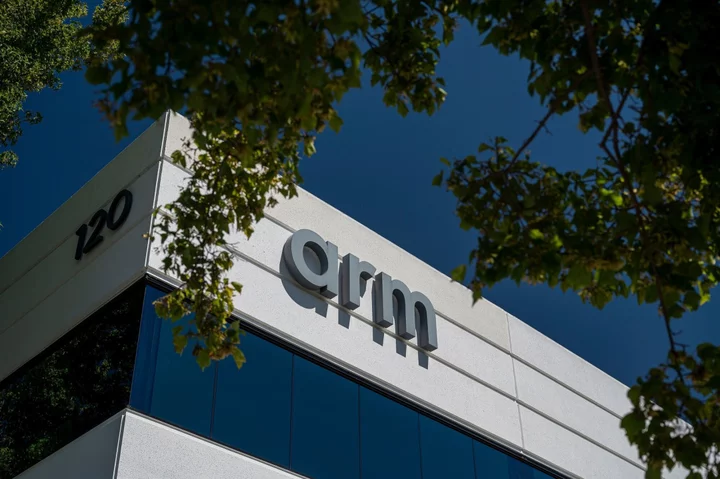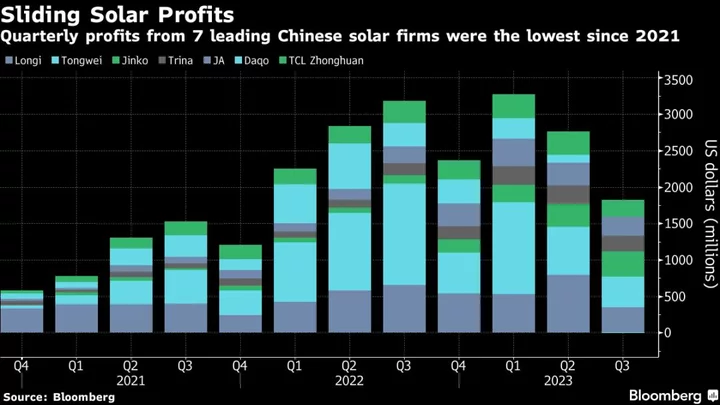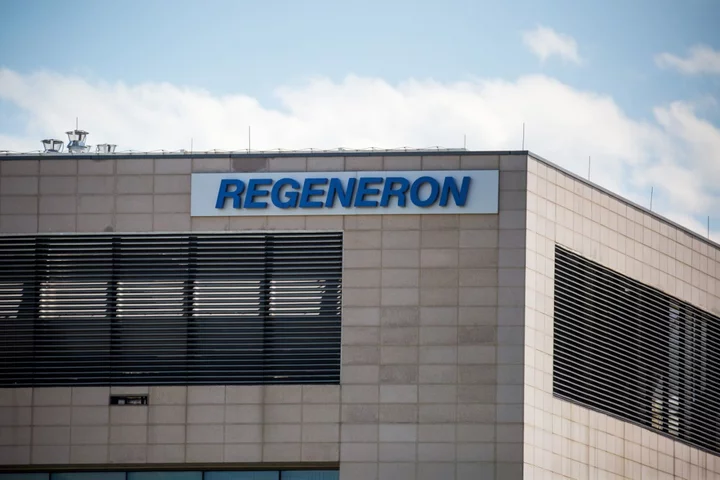Arm Holdings Plc, delivering the first earnings report since its initial public offering, gave a disappointing sales forecast as the company contends with a smartphone slump and uncertain timing for new licensing deals.
Revenue in the three months ending in December will be $720 million to $800 million, Arm said in a statement Wednesday. The midpoint of that range — $760 million — would fall short of the $773 million analysts have estimated.
That sent Arm shares tumbling as much as 9% in late trading. The rout threatens to wipe out all the stock’s gains since its IPO in September. It had been up 6.7% through Wednesday’s close.
Arm’s chip designs are widely used by smartphone makers, and the sluggish sales are a symptom of problems in that industry. Shipments of phones have slowed, with consumers hanging on to older models longer than in the past. Arm also gave a more conservative forecast because it’s unsure about the timing of licensing agreements and when the company will be able to report revenue for them.
“We’ve got a wide range, driven by: When do these large deals close?” Chief Executive Officer Rene Haas said in an interview.
Earnings will be 21 cents to 28 cents in the current quarter, excluding some items, Arm said. Analysts predicted 27 cents.
But results from the just-ended period were stronger. Revenue grew 28% to $806 million, topping the $747 million estimate. Excluding some items, earnings rose to 36 cents a share, compared with a 26-cent projection.
Arm isn’t a traditional chipmaker. It provides key parts of semiconductor designs and collects royalties from their use. It also licenses the fundamental technology governing how chips communicate with software.
On the plus side, Arm is benefiting from customers using its technology to create new semiconductors for artificial intelligence software and services. The company also is seeing more of its designs go into vehicles and infrastructure, which carry higher prices — and better royalties.
“The businesses where we’ve diversified into were very strong,” Haas said.
But investors have been waiting for signs that the smartphone industry is ready to bounce back. Arm is a bellwether because it designed much of the fundamental technology used by phone makers. And that industry is still just coming out of a trough, Haas said.
“We’re not immune to that,” he said.
Qualcomm Inc., the biggest seller of phone chips, gave a rosy forecast last week, raising hopes that the industry was recovering. Still, many manufacturers continue to face a glut of inventory.
A quarterly report by GlobalFoundries Inc., the largest US supplier of made-to-order semiconductors, also was cheered by investors this week. But that company indicated that oversupply problems are lingering, even as it gets better at coping with them.
Read More: How Arm Performed in Its First Day of Trading After IPO
Cambridge, England-based Arm is still 90%-owned by SoftBank Group Corp., which acquired the business in 2016 for $32 billion. The IPO raised $4.9 billion, marking the biggest debut on a US exchange this year. Following its return to public markets, Arm is now valued at nearly $56 billion.
Haas, who became CEO in February last year, has been trying to lessen Arm’s dependence on the smartphone industry by getting its technology into new areas such as personal computers and servers. It’s also offering more complete designs to phone customers, aiming to get more revenue per device sold.
Read More: Arm’s CEO Is Pitching a Made-For-You Chip Strategy
Arm’s licensing sales rose to $388 million last quarter, compared with an estimate of $327 million. Royalty revenue was $418 million, short of a prediction of $429 million.
Arm’s customer list spans the technology industry. Apple Inc. uses its instruction set for the processors that power the iPhone and Mac computers. Amazon.com Inc. relies on Arm designs for its Graviton server processors for data centers. Qualcomm and MediaTek Inc. are major users of Arm’s blueprints for smartphone processors, meaning the UK company’s technology is in every major device.
(Updates shares in third paragraph.)









